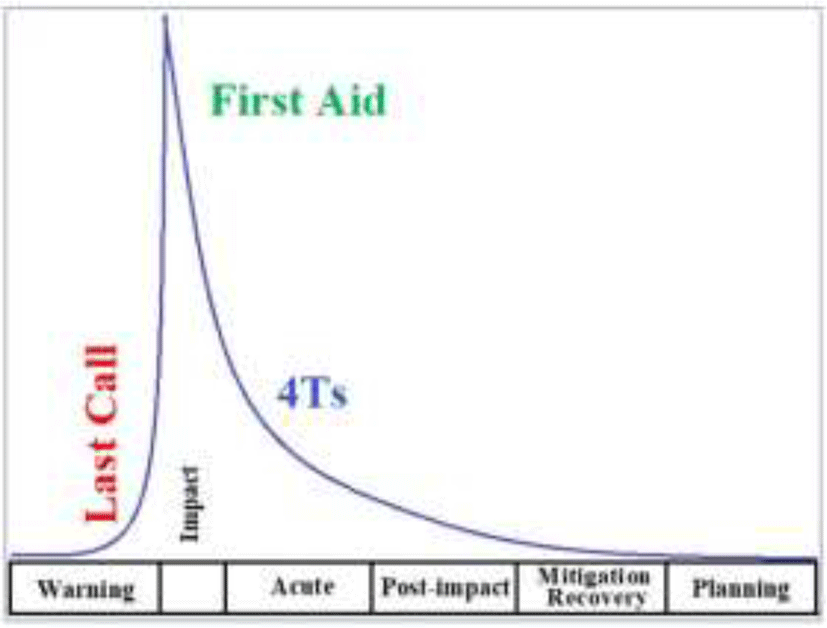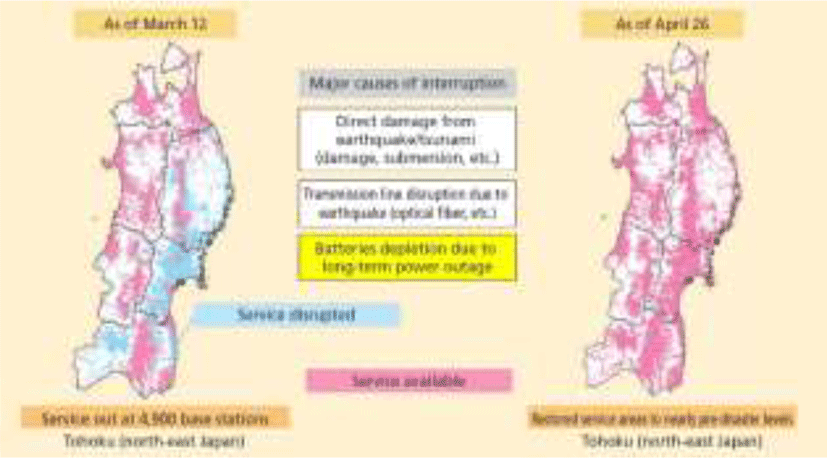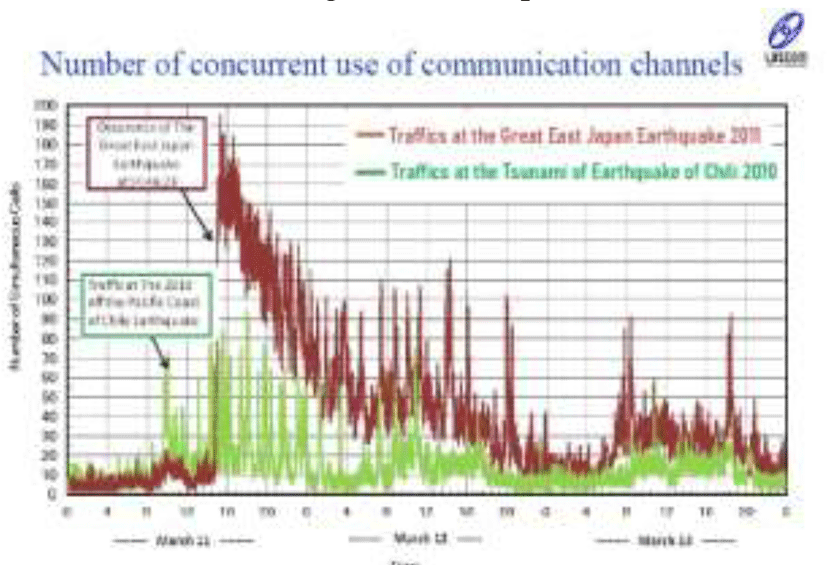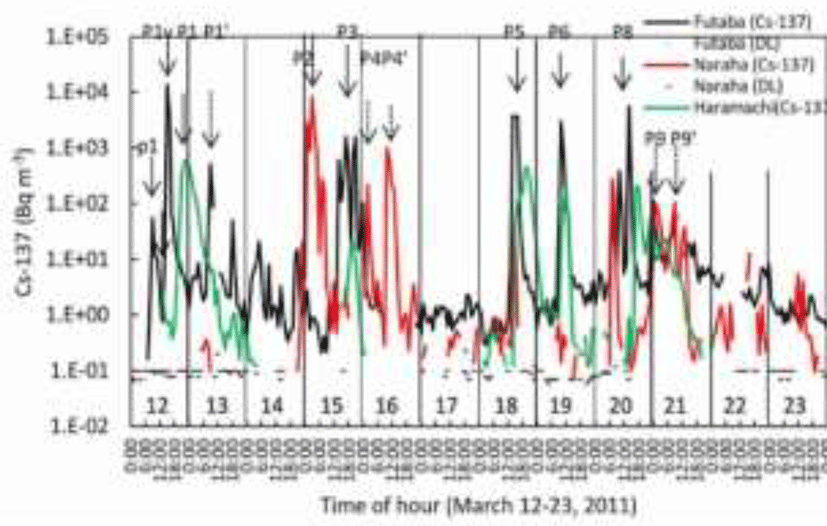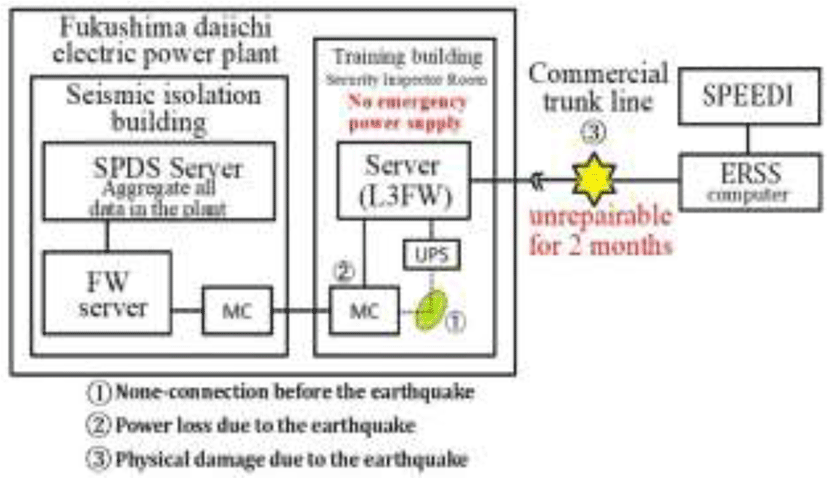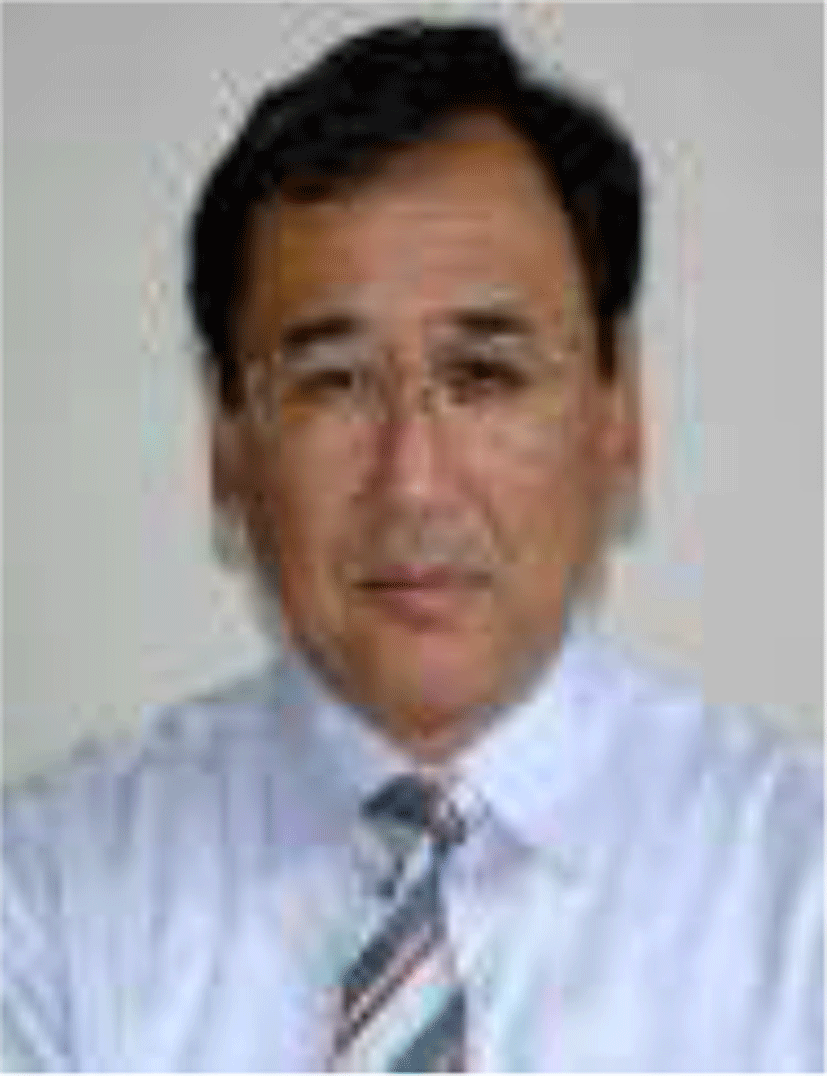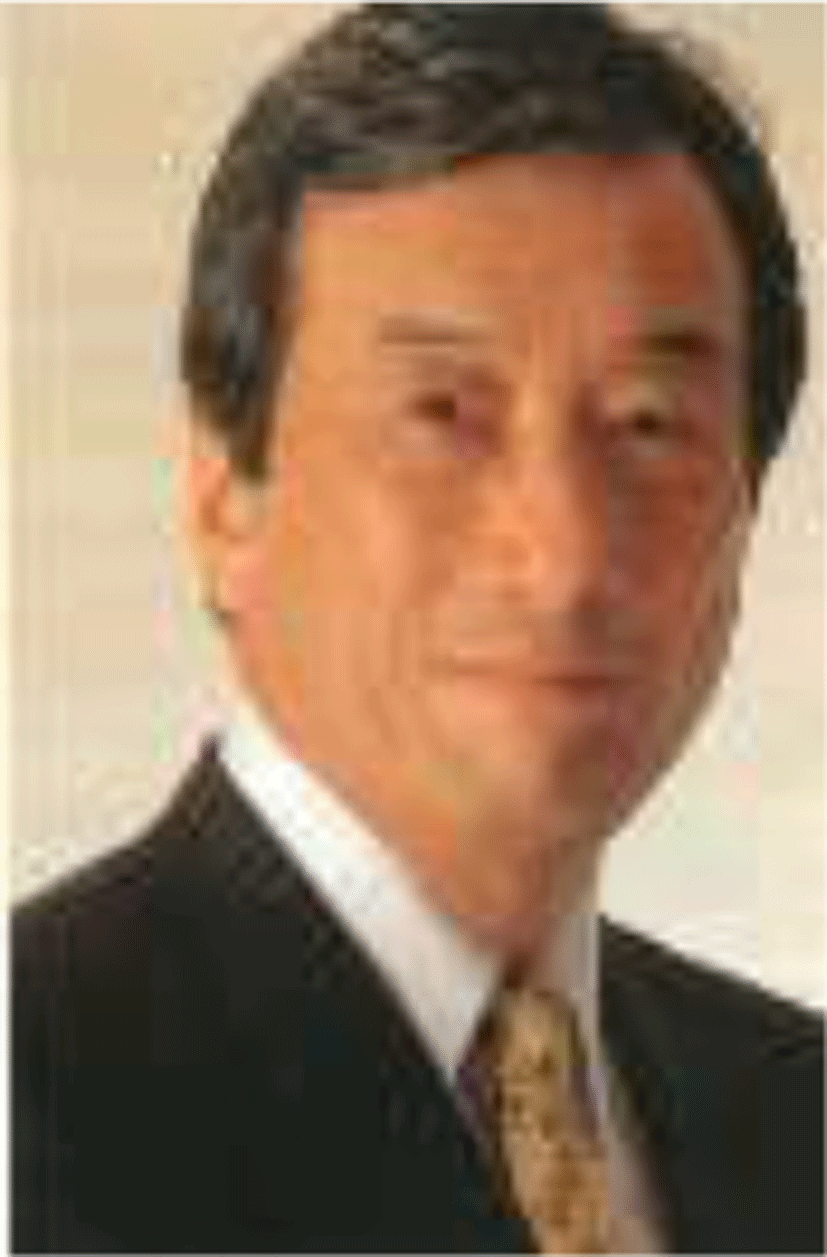I. PURPOSE
The Fukushima Nuclear Accident Independent Investigation Commission established by the National Diet of Japan has published a report on its investigation of the accident at the Fukushima nuclear power plant. In the fifth section of the Conclusion of the main report, which addresses the “causes for the escalation of damage,” the Commission concludes that some residents were exposed unnecessarily to radiation because the evacuation instructions “were not accurately conveyed to all area residents.” The following provides an analysis of this issue from the author’s perspective.
II. BACKGROUND
As a general rule, emergency communications (emergency call numbers such as “110,” “118,” and “119”) rely on public telecommunications networks (wired lines). However, wired lines can prove unreliable in the event of an earthquake. Although emergency radio communication systems may prove more reliable during disasters, citizens typically depend on fixed telephones or mobile phones to receive warning or messages. Let’s examine the emergency communication systems in Fukushima and its vicinity.
Formerly, the telecommunications industry in Japan was partly government-controlled. It has long since been completely privatized. In recent years, the telecommunications industry has operated based on market principles, while NTT East and NTT West operate emergency communication systems as a public service using the USF (Universal Service Fund) system. The USF system encompasses the maintenance of Type 1 public telephones and emergency communication systems. Needless to say, these operations do not generate sales, except for equipment upgrades and installation in HCA (high-cost areas). I conjecture that if a telecommunications company allocates a significant amount of funds to fulfill the USO (Universal Service Obligation), shareholders would see this as a loss-making, regulation-stifled business due to the wasteful allocation of funds. Given this management environment, we may need to reconsider whether the current system of maintaining emergency communications systems as a universal service obligation makes for a sound public policy. Due to the present system, Type 1 public telephones and emergency communication systems lacked secondary or tertiary fallback systems. I believe that the nuclear plant accident in Fukushima highlighted this inadequacy of the emergency communications infrastructure.
In this paper, “final decision call” and “last call” refer to the final communication of the warning to evacuate immediately in the event of an approaching tsunami. This public communication enhances the preparedness of rescue teams and helps ensure safety for residents. During the 9/11 terrorist attack on America, the “Get out!” call failed to reach all firefighters engaged in rescue activities in the two buildings, resulting in the death of many firefighters. Thereafter, in the United States, emergency communication lines were made distinct from the public network; independent radio communication networks are now being established across the US. A communication system used to issue a final decision call will not be simple. It must enable the central facility to consolidate all required information, as wells as to pass on instructions with specific information to targeted recipients. As the only public service that helps rescue teams make appropriate final decisions, these bidirectional communication channels must operate reliably during a disaster.
In the initial stages of disaster medical care and emergency medical care services, the following four(4) Ts must function smoothly: 4Ts, Telecommunications, Transportation, Triage, Early Treatment
Of these four, telecommunications and the mobility provided by transportation systems are essential for minimizing casualties during a large-scale disaster. While the private sector has proposed the use of ICT during post-disaster restoration periods, the national government must, as public policy, assume responsibility for response activities during the 48 to 72 hours following a disaster. Leaving this responsibility to the private sector and viewing this function as a pro bono service for an industry run on market principles amounts to negligent risk management on the part of the national government.
Disaster phases can be classified as follows. In the case of a nuclear power plant accident, the first 72 hours constitute the late phase of radiation exposure. During this phase, the national government must act to ensure the proper function of communication channels. After this phase, the communication networks operated by the private sector are likely to be restored. The correlation between last call, first aid, and acute phase is shown in Figure 1.
III. FACTS
Telecommunication conditions immediately after the accident at the Tokyo Electric Power Company’s Fukushima Dai-ichi Nuclear Power Plant(FDNPP)
According to the 2011 Information and Communications in Japan white paper, NTT DoCoMo’s telecommunication lines were virtually inaccessible for voice communication in Fukushima Prefecture immediately after the earthquake, due to congestion, power outages, and equipment failure, including repeater failures.
The volume of voice communications data involving NTT DoCoMo mobile phones increased by a factor of 50 to 60. Due to the dramatic increase in communications traffic, NTT DoCoMo imposed communication restrictions on up to 90% of attempted calls, while KDDI and SoftBank initiated restrictions on up to 95% and 70%, respectively. On the other hand, packet-based communications not conveying voice signals remained available for use, despite long delays. At 05:45 on March 12, 2011, all residents living in the area within a 10-km radius of the FDNPP were ordered to evacuate. However, this order failed to reach all residents, due to loss of power from Tohoku Electric Power Company (see Figure 2), which resulted in the shutdown of the repeaters handling mobile phone communications.
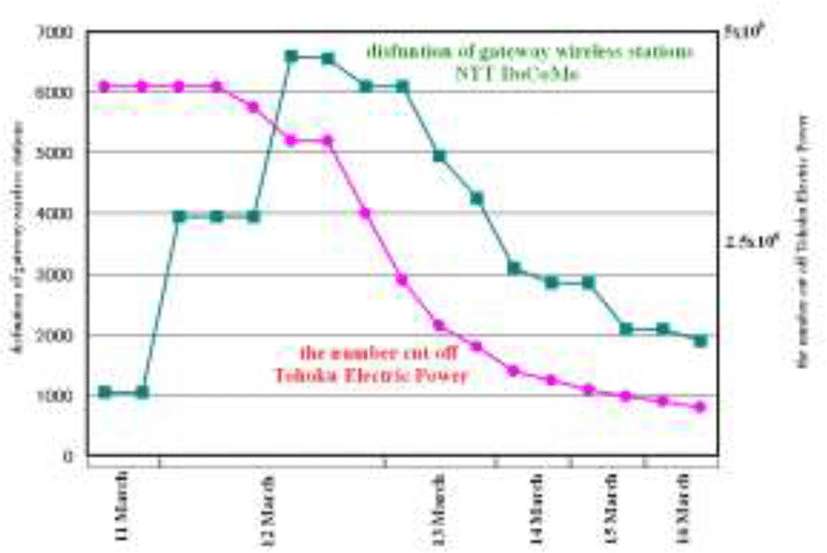
The service status of DoCOMo as of March 12, 2011 and April 26, 2011 is shown in Figure 3. It has taken 45 days to replace digital repeaters and repair the break in the main terrestrial line.
Numerous reports indicate that the “119” fire and emergency service line went down at this time, and that evacuation notices were issued by police radio. Since information was not disseminated effectively, and virtually no evacuation advice was given to vulnerable residents, many residents were unnecessarily exposed to radiation. a: On the premises of the Dai-ichi Nuclear Power Plant
The earthquake occurred at 14:46 on March 11, 2011. At the FDNPP, the emergency backup diesel generator supplying power to the three nuclear reactors (automatically halted by the earthquake) failed at 15:41. The absence of electricity to circulate cooling water through the reactors eventually resulted in a total of four explosions.
On the premises of the Tokyo Electric Power Company’s FDNPP, a local countermeasures headquarters was established to serve as a control tower to coordinate response activities. The emergency manual stipulated that headquarters communicate with workers using the personal handyphone system (PHS). However, power outages after the earthquake knocked out this system. The PHS system was restored on March 31, 2011, enabling limited communications. Since a primary function of the major structures on the premises of the nuclear power plant is to shield against radiation, signals are not readily transmitted through building walls to and from radio communications equipment and ordinary mobile phones. As a countermeasure, repeaters are installed inside and outside the facility buildings such as turbine buildings to allow use of PHS in disaster response activities. The Tokyo Electric Power Company was licensed by the Ministry of Internal Affairs and Communications to operate numerous small radio communication stations (400 MHz band) to supplement the PHS system. There are no reports indicating their effective use during accident response activities.
The traffic volume during the tsunami disaster caused by the Chilean Earthquake in 2010 is indicated by a green line. The brown color indicates the traffic volume during the 2011 Great East Japan Earthquake. LASCOM transponders only recognize several times the traffic volume compared to the Chilean earthquake. This traffic volume indicates that LASCOM was not being used as expected. In fact, the transponder of the LASCOM was empty.
As shown in Fig. 4, the LASCOM is a satellite network that is independent from the public circuit network, and was built for the purpose of
-
expanding and strengthening the disaster prevention administrative radio function,
-
transmitting administrative information, and
-
transmitting information from the community.
In the government offices, emails or voice records are not left as evidence, so the exchange of information by fax is used as an official communication, even in times of disaster.
A maximum of 195 lines were used by two Ku-band 36 MHz transponders, ten times the peak number of lines typically used. These lines maintained voice and fax transmissions between prefectural governments in the Tohoku region and local municipal governments (mayors of cities, towns, and villages). These were likely the most heavily used telecommunications lines during the disaster. However, certain terminals were unable to operate due to the failure of private generators after the power outage and could not be used for many hours until power from Tohoku Electric Power Company was restored. According to a recorded statement made by Minami Soma Mayor Katsunobu Sakurai, satellite communication access to the Local Authorities Satellite Communications Organization took at least 30 minutes to connect, due to congestion [01]. While the Japan Nuclear Energy Safety Organization and the nuclear power plants under the control of the organization once operated terminals connected to this network, 170 units were decommissioned on August 31, 2010, followed by another 68 terminals on March 31, 2011 (Figure 4). Thus, the Local Authorities Satellite Communications Organization network is no longer used for disaster communications during nuclear power plant accidents.
Emergency communication councils organized and operating under the guidance of the Ministry of Internal Affairs and Communications functioned poorly or not at all in respect of emergency communications involving the FDNPP accident. This was not due to the absence of radio communication stations in the areas, but because no order had been issued to convene these councils.
On March 12, the Ministry of Internal Affairs and Communications asked the Japan Amateur Radio League (JARL) to help secure emergency communication channels. JARL collected information on evacuation centers and other issues using emergency communication methods. JARL also leased 300 amateur radio communication units for use in the disaster-stricken areas. Use of amateur radio communication equipment for emergency communications is permitted as an exceptional case under Item 4 in Article 52 of the Radio Law.
The Ministry of Internal Affairs and Communications began leasing satellite phones at the request of local governments. Satellite phones proved invaluable, particularly in areas where the public telecommunications network was inoperable. However, requests from local governments located in areas close to the Fukushima Nuclear Power Plants—areas subject to high radiation doses—were unable to reach the Ministry. As a result, no satellite phones were provided to these areas. What’s more, the distribution of satellite phones occurred too late to reduce radiation exposures.
Based on the regulations specified in Article 61 (communication methods, etc.), Article 62 (operation of ship stations), Article 63 (compulsory operating time), Article 64 (silent time), and Article 70 (notification of entry to/egress from communication areas) of the Radio Law (Law No. 131, 1950) and to allow enforcement of the Radio Law, Article 17 of the Radio Regulatory Commission Foundation Law (Law No. 133 of 1950) stipulates regulations concerning comprehensive amendments of the Radio Station Operation Regulations. Article 129 of the Law applies to electric power equipment and facilities.
Priority order of notifications
Article 129: The priority order of notifications by communication methods specified in Item 1 in Article 74 of the Law is shown to the left. In the case of two or more notifications positioned at the same priority hierarchy, notifications must be transmitted in the order of acceptance or reception.
| Article 129 |
|---|
| 1. Notification pertaining to rescue required to protect human life |
| 2-7 and 9. Abbreviation |
| 8. Notification concerning repair/restoration of electric power utility facilities |
The Minister of General Affairs and Communications is authorized to issue orders to radio stations as needed to ensure that notifications are broadcasted to their destinations (i.e., that the appropriate communications or communication lines are secured for this purpose).
Tohoku Electric Power was not provided, and could not obtain wind direction information from PCs, TVs and mobile phones. The people had a battery-powered radio only.
The NHK radio 2(JOAB) announcer read the weather chart of the day of 06:00, 12:00 (noon), 18:00 Japan Standard Time on an AM radio broadcast. By drawing this weather map, the direction of the wind could be estimated. In particular, 90% of the total radiation scattered due to the rupture of Unit 2 occurred on March 15, 2011(peak of the scatter of I131), and on that day there was no incoming data from Onahama Meteorological Observatory in Fukushima Prefecture due to exposure, however based on the surrounding cities (Choshi, Maebashi, Sendai), it was able to find the direction to escape from the wind direction. It seems that very few people had this analog skill that can draw this weather map from verbal information (Figure 5 and 6).
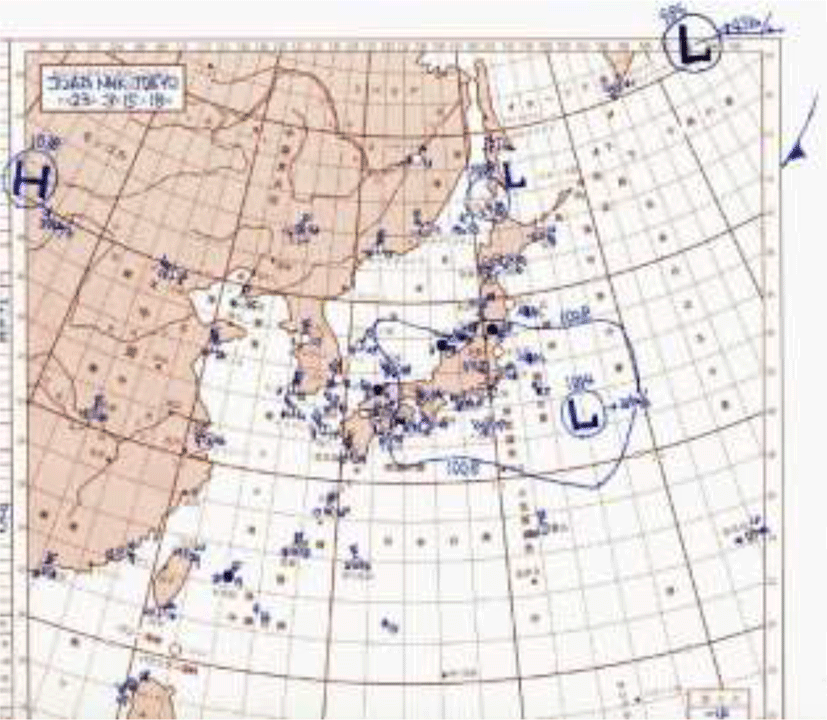
The relationship released I 131 and Cs 137 are in a linear, but the volatile I 131 scattered away in the wind. Report of Interdisciplinary Study on Inhalation Exposure and Risk Assessment Focusing on Suspended Particles Derived from the Nuclear Accident 5-1501 [6].
The function of this system is to predict the diffusion of radioactivity by a supercomputer based on scientific evidence such as weather conditions and topography such as wind direction, intensity, and the presence or absence of rain. During the Fukushima Nucler accident, the SPEEDI had no data on which to base a decision regarding the scope of the evacuation. Despite spending over 200 million USDs on this system, the Government issued an evacuation advisory based only on basic data that did not consider wind direction or 3-D terrain.
The first is a human error where the power cable to UPS, which supports the digital repeater called L3SW, was missing. Second, all AC power was lost. Third, the earthquake damaged two trunk lines (cables) (seaside and mountainside) of the telecommunications carrier (KDDI), requiring two months to repair (Figure 7). For these reasons, the SPEEDI was unable to display radiation scattering on a map.
Under the direction of the Japanese government, the Fukushima prefectural mayor issued three evacuation orders within a radius of 3km, 10 km, 20 km, and 30 km from the containment vessels, but these orders didn’t survive due to telecommunication failures. Residents missed the timing of evacuation and were forced to waste radiation (Figure8).
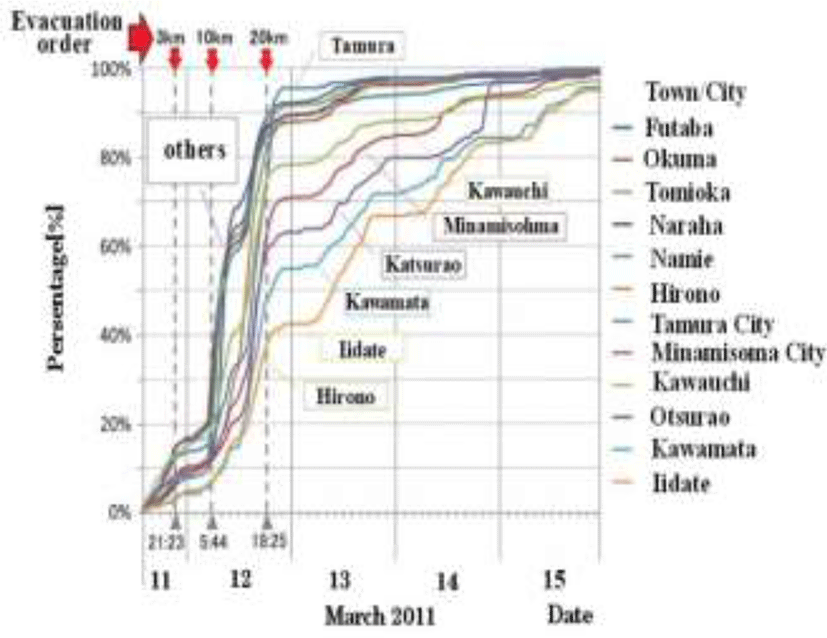
The mayor of Okuma Town has been notified of an evacuation order by police radio. Originally, it should be notified by LASCAOM, but the notification of an evacuation order by police radio has shown major problems of information transmission networks.
IV. REVIEW
Venting from a reactor releases radioactive materials into the atmosphere. Thus, residents must be evacuated from the surrounding area beforehand. The national government and the Tokyo Electric Power Company were responsible for notifying residents of the risk and proposed time of venting and for warning them to evacuate promptly. During the nuclear power plant accident, the communication systems of the surrounding municipal governments were rendered entirely nonfunctional, with the exception of the INMARSAT commercial line used by the Tokyo Electric Power Company. If an order had been issued pursuant to Article 129, it would have been possible—for example—to transmit noncommercial messages via radio equipment used by home delivery service companies. This, in turn, would have made it possible to warn farmers working in the fields to evacuate before the venting occurred.
“How many lives could have been saved had that instruction been issued?”; “How effective would it have been?”—Such arguments have no impact on judicial judgments. If the opportunity exists to save even one life, the Minister of General Affairs and Communications is responsible for issuing the order to use all possible communication methods to notify residents of the final decision call. The Radio Law was established based on the Constitution of Japan. Its highest priority is to protect a citizen’s fundamental right to life. Since no orders were issued during the nuclear power plant accident, the emergency communication councils, which could have assumed a communications role, took no action to communicate the information vitally needed.
The accident at the FDNPP was not an isolated incident. It took place concurrently with the disaster and damage caused by the Great East Japan Earthquake. This, to a large extent, is why measures to secure communication channels and power could not be implemented, unlike in other localized accidents. (1) Communications with the area where the nuclear power plant was located and nearby local governments were made via the INMARSAT communication satellite, but information was not disseminated as it should have been. Instructions to evacuate failed to reach many residents in a timely fashion. (2) The “119” fire and emergency service lines (included in the scope of the Universal Service Obligation (USO)) were rendered inoperative in the abovementioned area. (3) The number of public telephones (also included in the scope of the USO) in the area proved insufficient. (4) Radio communication systems (PHS, mobile phones) on the premises of the FDNPP stopped working. Given these communication conditions, information on venting and instructions to evacuate failed to reach many residents, causing confusion among residents and exposing residents to radiation. These problems should have been resolved immediately by taking appropriate measures.
The Law mentioned in this paper is among a handful of regulations pertaining to electric power utility facilities that empower the Minister of General Affairs and Communications to issue orders to radio stations to ensure minimum notifications are broadcasted to their destination (i.e., that the appropriate communication or communication lines are secured for this purpose) under the communication circumstances described in (1) through (4). Thus the organizations in question failed to sufficiently examine all possible means by which orders could be issued, despite their obligation to do so.
Under what kinds of national crisis should the notification specified in Item 8—one not issued during the FDNPP accident—be issued? If another nuclear power plant accident should occur in the future and compel the evacuation of nearby residents and if the appropriate communication environment is unavailable, the Minister of General Affairs and Communications must issue prompt orders to all radio stations pursuant to Article 129.
V. CONSIDERATIONS
The 9/11 incident in the United States resulted in loss of life among many of the firemen called. A major factor was the failure of the final decision call to reach all firemen in harm’s way. Since then, private radio communication networks have been established independently of public lines. Similarly, instructions to evacuate failed to reach many residents after the Fukushima Nuclear Power Plant accident. In Japan, the importance of the final decision call was not adequately recognized. For this reason, there was no advance consideration of the organizations ideally suited to implement the call; of the procedures for issuing the call; or of specifics such as a well-established command system and communication routes for the centralization and distribution of information, communication methods, or contingency planning for various potential scenarios. The “119” fire and emergency service line, a universal and obligatory service, and other emergency communication systems in Fukushima Prefecture failed. These events argue for establishing physically redundant communication lines. The reactor venting, such highly risk events had a right to be noticed to all residents via any communications tools beyond terminals licenses based on the Article 129 of the Radio Station Operation Regulations. Nevertheless, the failure of the government to issue the Article 129 is nothing but the negligence of the Japanese government. It is necessary for the Japanese government to legally add an emergency digital communication network (third party communication independent of the public line) beyond the scope of license under the Article 129. It will be a digital gateway system during emergency situation to support “Last Call” The lack of access to functioning communications prevented residents from evacuating and blocked the rescue of residents exposed to radiation and the provision of emergency medical care. The organizations in question must reflect on the events associated with the nuclear power plant disaster in Fukushima and review their emergency and disaster communication systems in light of potential future events.
The Japanese Government and bureaucrats are good at operating known things accurately but are very poor at crisis management for unknown and unforeseen disasters. February 2020, treatment of coronavirus infections that broke out on a large cruise ship anchored at port Yokohama was often negligent [19-20]. and only observations such as temperature measurements were performed. The mobile phone inside Diamond Prince at Port Yokohama could not be used, and messages were sent in humans. This is very similar to what the TEPCO testified that the PHS was not available at TEPCO’s Fukushima nuclear power plant and that it became a message game. The fact of the propagation condition of inside the Diamond Princess is contained in the Japanese Self-Defense Force’s short report. There were lots of problems for one week until placing digital repeaters in the ship and placing the gathering vans for mobile phone communications outside beaming to the ship. The main cause is that both are covered with iron, and the radio waves are shielded and cannot reach. It should be noted that such inaccuracies in communication during a disaster can be fatal.
Politicians and bureaucrats have the fatal disadvantage, because they do not want to take responsibility. All orders are governed by a general agreement called “group thinking”. This decision is time consuming and involves the danger of distorting facts. It may be wrong that they perform crisis management. In India, crisis management is led by a private, independent organization. The time has come for Japan to reconsider the way crisis management should be.
VI. CONCLUSION
Information transmission failures at the Fukushima nuclear accident include: 1) power outages due to physical factors such as earthquakes and tsunamis; 2) congestion failures due to increased communication calls; 3) USO contract violations; and 4) Communications Act No. 129. 5) Decreased use of LASCOM, 6) SPEEDI malfunction, and evacuation orders such as “Escape!” could not be transmitted to residents, and residents were exposed to unnecessary radiation.
In the future, the 3rd-party wireless communications, including amateur radios, should be prepared and automatically checked by short packets on a daily basis as wireless digital circuits that are physically connected, even if they are not licensed communication partners. It will take time for central ministries to determine whether or not to issue a command, so it should be left to the individual judgment onsite. It is also necessary to aim at reforming the decision system of “group thinking” like Japanese bureaucrats and the prime minister’s house “Kantei” [3,18]

